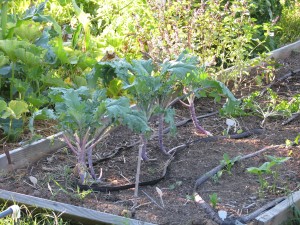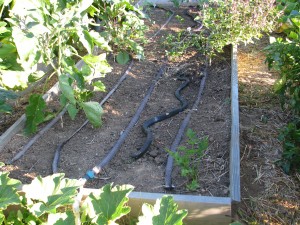A Garden Reconsidered

In the August of one of my most successful years of vegetable growing, as the squash vines wither to reveal the graceful shapes of winter stews, and the cabbage moth caterpillers chew collards into lace, I am able to review and make notes on triumphs and things not-as-good-as-one-would-hope. Gardening is as much a practice as medicine, but healthier. What works one year may not work the next; for instance, there are melon years and no-melon years. A gardener can worry about the soil, the water, the sunlight and the bugs, but come to discuss the problem with enough other gardeners and there is sure to be at least one who didn’t have a good melon year either. Whether there is astrological truth in it or not, it matters not except to bring relief from the strain of worrying if there were no melons because of a fault in the gardener.
Here is my list of things that didn’t go as planned, and resolutions to improve next year:
1. Trim back foliage to make sure there isn’t something drinking all the water.

2. Check for volunteers, especially those hitchhikers from the compost who decide to sprout.

3. Don’t think you’re going to pinch the tomatoes back so that they grow onto a large trellis, especially since you don’t make the trellis. Tomatoes need some light to produce and ripen.

4. Warn visitors early about the rubber snakes.

5. Count backwards from Halloween the estimated ripen days on the seed packet, and don’t plant too early. That way your pumpkins won’t be ripe in August. Also, plant herbs such as dill and cilantro early and thick long before cucumbers, so that you have the seed heads ready when it is time to make pickles.

6. There only needs to be one zucchini plant.

7. Prepare to stake everything. With wire-lined raised beds you can’t plunge a stick down into the soil next to a wobbly plant. You have to attach the stakes to the sides of the bed, or drive them down outside of the bed and make T’s. Whatever the choice, it is best done before the plants are mature.

8. Plant lots of kale. It is extremely tasty sauteed, and drying the oiled leaves to make kale chips (see recipe section) makes a nutritious and addicting snack.

9. Again, keep volunteers under control. This kabocha squash took over three vegetable beds and two pathways. However, it is producing some mighty fine squash.

10. Rubber snakes are remarkably effective in preventing crows from eating seeds. However, besides warning visitors, don’t forget where you’ve tossed your rubber snakes if you are reaching into a leafy dark space at twilight!
